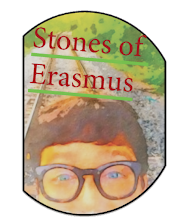Hi, I’m Greig — welcome! Here you’ll find sharp writing, creative ideas, and standout resources for teaching, thinking, making, and dreaming in the middle and high school ELA and Humanities classroom (Grades 6–12).
4.4.25
Interpreting William Blake’s ‘London’: A Deep Dive into 18th Century British Society
 I am an educator and a writer. I was born in Louisiana and I now live in the Big Apple. My heart beats to the rhythm of "Ain't No Place to Pee on Mardi Gras Day". My style is of the hot sauce variety. I love philosophy sprinkles and a hot cup of café au lait.
I am an educator and a writer. I was born in Louisiana and I now live in the Big Apple. My heart beats to the rhythm of "Ain't No Place to Pee on Mardi Gras Day". My style is of the hot sauce variety. I love philosophy sprinkles and a hot cup of café au lait.
29.3.25
Poem: The Bars Closed / So Are We
 Most mornings, I rouse myself—
Most mornings, I rouse myself—
today, the clock glares at 4:22,
propped up in my temple-bed.
Mornings always feel so hard,
but I’m determined—
I fish for clothes in the hamper
and push myself out into bleak, wet Queens.
You know, after 4 AM is a switch point:
New York City’s bars have closed,
spilling a puddle of people
onto the damp streets—
Megan, all curves on Roosevelt Avenue,
and denizens of the club,
shouting loudly and hugging each other
in their glaring halter tops
and early spring jerseys—
like completing a ritual, inebriated but satisfied,
reluctant to return
to whatever fragile domesticity waits.
I’m with them—
just trying to catch a train.
And in that crowd,
something inside me steadies,
as though I’ve found a handle
on the world for a moment,
glad not to be alone
in my own head.
By the time I meet Joshua at Penn Station,
I’m more myself,
a quiet song building in my mind.
He’s already awake,
his T-shirt too tight but somehow easy on him.
I grin at how polite he is
to the train attendant,
asking where coach class is—
I could have told him,
but I’m busy weaving stories
in my head, barely hearing him say,
“I’m glad you’re with me.”
 I am an educator and a writer. I was born in Louisiana and I now live in the Big Apple. My heart beats to the rhythm of "Ain't No Place to Pee on Mardi Gras Day". My style is of the hot sauce variety. I love philosophy sprinkles and a hot cup of café au lait.
I am an educator and a writer. I was born in Louisiana and I now live in the Big Apple. My heart beats to the rhythm of "Ain't No Place to Pee on Mardi Gras Day". My style is of the hot sauce variety. I love philosophy sprinkles and a hot cup of café au lait.
20.3.25
Unlocking Greek Mythology: Fresh Vocabulary Lessons Your Students Will Love Before Spring Break!
 |
| I sell quality humanities-content on TpT. Thank you for supporting Stones of Erasmus. |
 |
| Students love working with these myth-related vocabulary cards. Buy them on the Stones of Erasmus TpT store. |

 I am an educator and a writer. I was born in Louisiana and I now live in the Big Apple. My heart beats to the rhythm of "Ain't No Place to Pee on Mardi Gras Day". My style is of the hot sauce variety. I love philosophy sprinkles and a hot cup of café au lait.
I am an educator and a writer. I was born in Louisiana and I now live in the Big Apple. My heart beats to the rhythm of "Ain't No Place to Pee on Mardi Gras Day". My style is of the hot sauce variety. I love philosophy sprinkles and a hot cup of café au lait.
6.2.25
Flash Fiction: Hashtag Smart (A Story Out of School)
 I am an educator and a writer. I was born in Louisiana and I now live in the Big Apple. My heart beats to the rhythm of "Ain't No Place to Pee on Mardi Gras Day". My style is of the hot sauce variety. I love philosophy sprinkles and a hot cup of café au lait.
I am an educator and a writer. I was born in Louisiana and I now live in the Big Apple. My heart beats to the rhythm of "Ain't No Place to Pee on Mardi Gras Day". My style is of the hot sauce variety. I love philosophy sprinkles and a hot cup of café au lait.
28.1.25
My Journey of Personal Growth: A Forty-something’s Self-Reflection
 |
| Me in a family Christmas photo—I'm like nine or ten (circa 1989) |
 |
| Me in the Late Nineties Entering Ms. Decker's Freshman Biology Class Image Credit: Mandeville High School Yearbook |
 |
| Me in my early 30s |
“I pray you are having a good day. Stay safe!! I’m proud of the hard work you do. Love you!—Mom!”
 |
| Me in my room in New York City in My 40s |
 I am an educator and a writer. I was born in Louisiana and I now live in the Big Apple. My heart beats to the rhythm of "Ain't No Place to Pee on Mardi Gras Day". My style is of the hot sauce variety. I love philosophy sprinkles and a hot cup of café au lait.
I am an educator and a writer. I was born in Louisiana and I now live in the Big Apple. My heart beats to the rhythm of "Ain't No Place to Pee on Mardi Gras Day". My style is of the hot sauce variety. I love philosophy sprinkles and a hot cup of café au lait.
26.1.25
The Surprising Roots of “Community” and the Hidden Boundaries We Create
One thing I’ve learned from examining words closely is how revealing they can be—and how often they point to tension between binary forces we tend to take for granted. Consider “community.” We typically see it as a positive term for belonging, yet when we deconstruct it, we uncover both unity and the idea of separation.
The co- prefix (from Latin) means “together” or “with,” as in cooperate (to work together) or coexist (to exist alongside). Then there’s the muni element. It likely stems from the Latin munire (“to fortify” or “protect”), which in turn relates to moenia (Latin for “defensive walls”). We see this military flavor in words like munitions (armaments or weaponry).
So while “community” conjures an image of people coming together, its deeper linguistic roots hint at building boundaries or fortifications to keep threats out. This creates a subtle tension—every act of inclusion or togetherness can imply an outside that’s excluded. By probing the origins of everyday words like this, we see how language itself encodes a push-and-pull between openness and defense, raising important questions about who belongs and who remains on the outside.
 I am an educator and a writer. I was born in Louisiana and I now live in the Big Apple. My heart beats to the rhythm of "Ain't No Place to Pee on Mardi Gras Day". My style is of the hot sauce variety. I love philosophy sprinkles and a hot cup of café au lait.
I am an educator and a writer. I was born in Louisiana and I now live in the Big Apple. My heart beats to the rhythm of "Ain't No Place to Pee on Mardi Gras Day". My style is of the hot sauce variety. I love philosophy sprinkles and a hot cup of café au lait.

